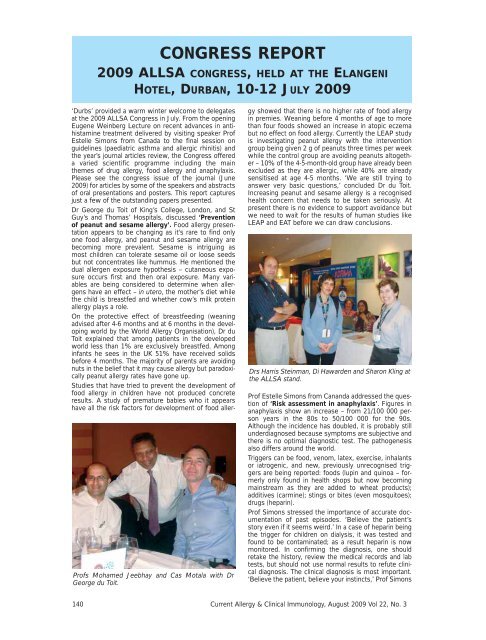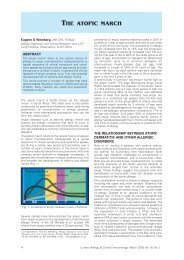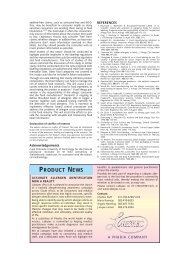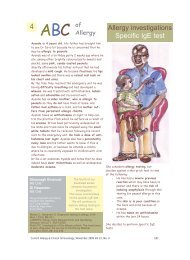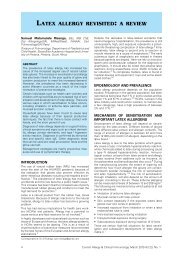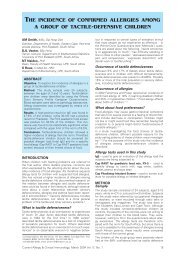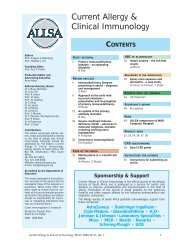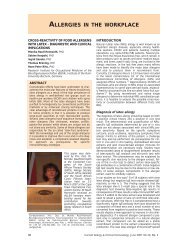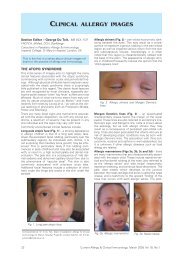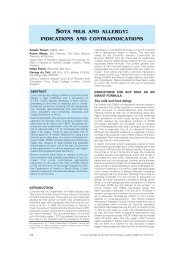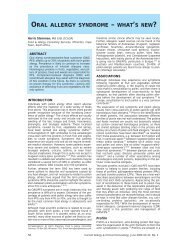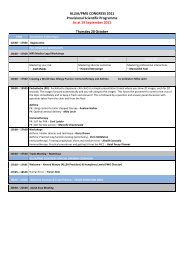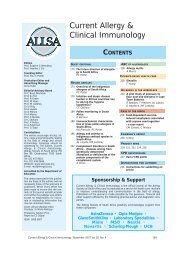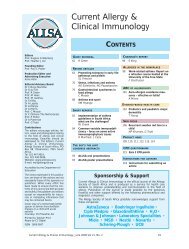Current Allergy & Clinical Immunology - ALLSA
Current Allergy & Clinical Immunology - ALLSA
Current Allergy & Clinical Immunology - ALLSA
You also want an ePaper? Increase the reach of your titles
YUMPU automatically turns print PDFs into web optimized ePapers that Google loves.
CONGRESS REPORT<br />
2009 <strong>ALLSA</strong> CONGRESS, HELD AT THE ELANGENI<br />
HOTEL, DURBAN, 10-12 JULY 2009<br />
Profs Mohamed Jeebhay and Cas Motala with Dr<br />
George du Toit.<br />
‘Durbs’ provided a warm winter welcome to delegates<br />
at the 2009 <strong>ALLSA</strong> Congress in July. From the opening<br />
Eugene Weinberg Lecture on recent advances in antihistamine<br />
treatment delivered by visiting speaker Prof<br />
Estelle Simons from Canada to the final session on<br />
guidelines (paediatric asthma and allergic rhinitis) and<br />
the year’s journal articles review, the Congress offered<br />
a varied scientific programme including the main<br />
themes of drug allergy, food allergy and anaphylaxis.<br />
Please see the congress issue of the journal (June<br />
2009) for articles by some of the speakers and abstracts<br />
of oral presentations and posters. This report captures<br />
just a few of the outstanding papers presented.<br />
Dr George du Toit of King’s College, London, and St<br />
Guy’s and Thomas’ Hospitals, discussed ‘Prevention<br />
of peanut and sesame allergy’. Food allergy presentation<br />
appears to be changing as it’s rare to find only<br />
one food allergy, and peanut and sesame allergy are<br />
becoming more prevalent. Sesame is intriguing as<br />
most children can tolerate sesame oil or loose seeds<br />
but not concentrates like hummus. He mentioned the<br />
dual allergen exposure hypothesis – cutaneous exposure<br />
occurs first and then oral exposure. Many variables<br />
are being considered to determine when allergens<br />
have an effect – in utero, the mother’s diet while<br />
the child is breastfed and whether cow’s milk protein<br />
allergy plays a role.<br />
On the protective effect of breastfeeding (weaning<br />
advised after 4-6 months and at 6 months in the developing<br />
world by the World <strong>Allergy</strong> Organisation), Dr du<br />
Toit explained that among patients in the developed<br />
world less than 1% are exclusively breastfed. Among<br />
infants he sees in the UK 51% have received solids<br />
before 4 months. The majority of parents are avoiding<br />
nuts in the belief that it may cause allergy but paradoxically<br />
peanut allergy rates have gone up.<br />
Studies that have tried to prevent the development of<br />
food allergy in children have not produced concrete<br />
results. A study of premature babies who it appears<br />
have all the risk factors for development of food allergy<br />
showed that there is no higher rate of food allergy<br />
in premies. Weaning before 4 months of age to more<br />
than four foods showed an increase in atopic eczema<br />
but no effect on food allergy. <strong>Current</strong>ly the LEAP study<br />
is investigating peanut allergy with the intervention<br />
group being given 2 g of peanuts three times per week<br />
while the control group are avoiding peanuts altogether<br />
– 10% of the 4-5-month-old group have already been<br />
excluded as they are allergic, while 40% are already<br />
sensitised at age 4-5 months. ‘We are still trying to<br />
answer very basic questions,’ concluded Dr du Toit.<br />
Increasing peanut and sesame allergy is a recognised<br />
health concern that needs to be taken seriously. At<br />
present there is no evidence to support avoidance but<br />
we need to wait for the results of human studies like<br />
LEAP and EAT before we can draw conclusions.<br />
Drs Harris Steinman, Di Hawarden and Sharon Kling at<br />
the <strong>ALLSA</strong> stand.<br />
Prof Estelle Simons from Cananda addressed the question<br />
of ‘Risk assessment in anaphylaxis’. Figures in<br />
anaphylaxis show an increase – from 21/100 000 person<br />
years in the 80s to 50/100 000 for the 90s.<br />
Although the incidence has doubled, it is probably still<br />
underdiagnosed because symptoms are subjective and<br />
there is no optimal diagnostic test. The pathogenesis<br />
also differs around the world.<br />
Triggers can be food, venom, latex, exercise, inhalants<br />
or iatrogenic, and new, previously unrecognised triggers<br />
are being reported: foods (lupin and quinoa – formerly<br />
only found in health shops but now becoming<br />
mainstream as they are added to wheat products);<br />
additives (carmine); stings or bites (even mosquitoes);<br />
drugs (heparin).<br />
Prof Simons stressed the importance of accurate documentation<br />
of past episodes. ‘Believe the patient’s<br />
story even if it seems weird.’ In a case of heparin being<br />
the trigger for children on dialysis, it was tested and<br />
found to be contaminated; as a result heparin is now<br />
monitored. In confirming the diagnosis, one should<br />
retake the history, review the medical records and lab<br />
tests, but should not use normal results to refute clinical<br />
diagnosis. The clinical diagnosis is most important.<br />
‘Believe the patient, believe your instincts,’ Prof Simons<br />
140 <strong>Current</strong> <strong>Allergy</strong> & <strong>Clinical</strong> <strong>Immunology</strong>, August 2009 Vol 22, No. 3


